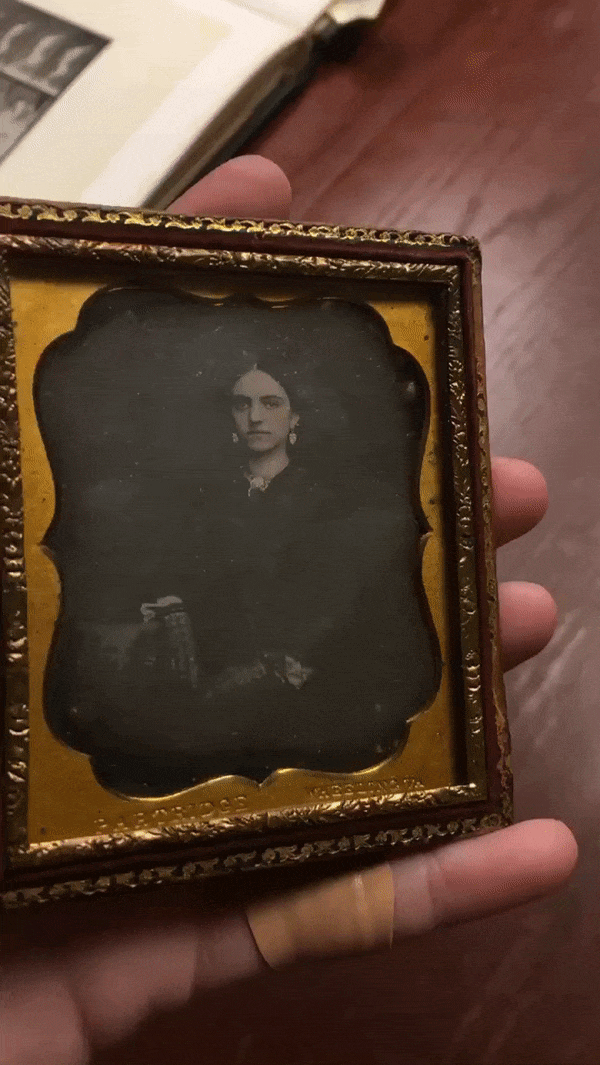Like Cyanide and Spirits, this essay reveals some of the forgotten history of the way photography—specifically the daguerreotype—was conceptualized in its earliest days.
The daguerreotype is the first stable photographic process and when we talk about the invention of photography in 1839, it’s the daguerreotype that we’re talking about. It’s named after its inventor, Louis Jacques Mandé Daguerre (more on this in a post later this month!)
Daguerreotypes are magical in and of themselves. If you’ve ever seen one up close, you know what I’m talking about. If you haven’t seen one before, I’ll do my best to describe them (incidentally, that’s exactly what Susan S. Williams is analyzing in this essay—how Victorian writers grappled with the magic of the daguerreotype in their stories. But I’ll get to that in a minute).

Unlike most photographs that we have experience within our lifetime, daguerreotypes are one-of-a-kind. They are not prints from a negative. They are unique objects and in this way are more like a miniature painting than a photograph.
Also unlike most photographs that we’re familiar with, the image created via the daguerreotype process is on metal not paper. Daguerreotypes are made with highly polished silver-coated copper plates which were never larger than 6.5 x 8.5 inches. They are so highly polished that they are reflective, like a mirror. The viewer of a daguerreotype, holding the object in their hand, would have to tilt the surface to catch the right light for the image to be legible. Depending on how the light strikes the plate, the viewer can see the image in negative, as a positive, or with their own reflection superimposed.
The detail captured and reproduced in daguerreotypes is unmatched by any photographic process that followed, and certainly more detailed than any portrait painting that 19th century sitters would have commissioned. Because of the silvery cast of the plate, and the fact that color was not one of the details the daguerreotype was capable of reproducing, portraits were often accented with color pigment applied by hand to give flesh, jewels, and luxe fabrics a more naturalistic appearance.
In the popular imagination daguerreotypes were both objects of great technological and scientific achievement, and simultaneously magical, talismanic, even divine. The essay I’m featuring is about the written responses (via fiction) to the representational power of the daguerreotype. Since no verbal description could be as accurate and complete as a daguerreotype, writers often turned to the magical qualities of daguerreotypes to propel their narratives, ones where daguerreotypes had nearly the same agency (and in some cases more!) as humans in the stories.
We are all familiar with the saying that a picture’s descriptive power is “worth a thousand words.” It would take a thousand words to describe a the detail that a photograph could reproduce. This proved a challenge to writers. Obviously writers who were integrating daguerreotypes into their stories still had to describe the daguerreotype that was central to their narrative, but was the actual subject of the photograph all that important? Would the particularities of one person’s portrait over another made any difference at all in their narrative?
Writers instead expected that their readers would have experienced holding and looking at daguerreotypes of their own. They depended on their readers’ experiences of having experienced the mimetic capabilities to fill in the function of description. Readers in effect were free to picture themselves or anyone they knew as the subjects of the portraits in contemporary stories.
Because the average person would not have knowledge of how the magical images were made, writers sometimes characterized daguerreotypists as mad scientists (the beginning of a trope that—according to Cyanide and Spirits may not have been too far from the truth in some cases—has had a long life in popular culture). Images had a darker side in the popular imagination that writers jumped on for their stories.
One common literary device that Williams reveals is the doubling of a character by means of the existence of their daguerreotype portrait. In other words, the daguerreotype may have experiences or gain access to places that the person (perhaps ill at home, or simply a woman) would not. Some protagonists fell in love with daguerreotype images which acted as a surrogate for a woman who the person marries in the end. The daguerreotypes travel in pockets to dangerous locations, even save lives by stopping knives from piercing flesh. Though the images are static, they are sometimes given a certain agency in the story. However, the narrative tension remains because ultimately the daguerreotype is also a commodity that can be exchanged and circulate without the sitter’s knowledge.
The final story that Williams discusses in this essay is the one it is named for: “The Inconstant Daguerreotype” which was published in Harper’s Magazine in 1855. In it, two daguerreotypes fall in love with each other. They have the agency to experience emotions, but not to save each other from being stolen from the wall they both hang on, or to prevent each other’s destruction.


0 Comments